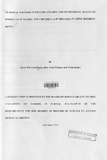| dc.description.abstract | Climate variability and change which is a global issue may directly affect seasons, either
negatively or positively determining agricultural food production. Nutritional status of any
population is highly dependent on agricultural food production and therefore depending on
the seasonal effect, may result to poor or good status. In Kenya, especially in the arid and
semi arid areas, seasonal variation is common, giving rise to inconsistent agricultural food
production hence food insecurity.
In many communities, though the nutritional status is affected generally in the entire
household, it is more severe within the child bearing women of 15-49 years of age and
children under the age of five years (6-59months) who are the more vulnerable groups.
The objective of the study was to establish, the seasonal variability in food security, dietary
intakes and nutritional status of children 6 -59 months of age and women 15-49 years in two
climatic seasons. The hypothesis was that seasonal variability contributes significantly to the
food insecurity status in Kitui.
The study was cross-sectional in which data was collected in two phases, the long rains
harvest period (July 2008) and the short rains harvest period (March 2009) and these were,
season 1 which had 147 households surveyed and season 2 had 171 households respectively.
In both seasons, household level survey, collected data on food production, employment
status and incomes, expenditures, assets, morbidity, and dietary intakes and anthropometric
measurements on women and children. Independent samples t-test, and Mann- Whitney tests
were used to compare the two seasons. Predictor variables for children's nutritional status
were assessed by binary logistic regression. Reference was also made to the existing food
production and climatic data.
The levels of food insecurity, and the prevalence underweight and stunting in children were
found significantly higher during the short rains harvest period compared to the long rains
harvest period. Household median production of maize dropped by about 70%, and beans by
50% during the short rains harvest season. Dietary intakes and dietary diversity in terms of
energy and nutrient intake fluctuated significantly between the two seasons, worse off during
the short rains harvest period. Though the nutritional status of the women did not change
significantly between the seasons, more underweight women were found during the short
rains harvest period. Household income and consumption frequency of some locally
produced foods positively correlated (significantly) with nutritional status. Diet based coping
strategies did not seem to influence nutritional status significantly. Seasons, consumption
frequency of beans per week and household size, were found to be appropriate predictors of
nutritional status of children on a multivariate regression analysis.
Seasonal variability had a significant contribution on food security, dietary intakes and
nutritional status of the children but not of the mothers. The short rains season was worse off
than the long rains season in terms of produced food, dietary intakes and dietary diversity,
employment, incomes, expenditures and nutritional status. The study recommends that
adaptation measures specific to the region need to be designed to enable the small holder
farmer boost the food security status and mitigate declining nutritional status. | en |

